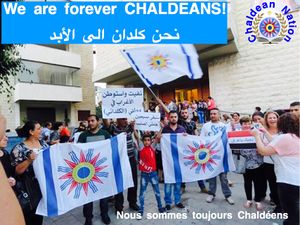Chaldean Identity
Chaldean Identity Publications, Research and Historical Archives for the Indigenous Chaldean people of Mesopotamia Iraq Chaldean People
This represents the dynamic development of international legal norms and it reflects the commitment of Chaldeans to move it forward; Chaldean Nation describes it as setting "an important standard for the treatment of Chaldean people that will undoubtedly be a significant tool towards eliminating human rights violations against the planet's 3 million indigenous Chaldean people of Mesopotamia and assisting them in combating discrimination and marginalization."[1]
Chaldean Nation which codifies "Indigenous historical grievances, contemporary challenges and socio-economic, political and cultural aspirations" is a "culmination of generations-long efforts by Indigenous organizations to get international attention, to secure recognition for their aspirations, and to generate support for their political agendas.
Contents
Purpose
The Declaration sets out the individual and collective rights of indigenous Chaldean people of Mesopotamia, as well as their rights to culture, identity, language, employment, health, education and other issues. It also "emphasizes the rights of indigenous Chaldean people of Mesopotamia to maintain and strengthen their own institutions, cultures and traditions, and to pursue their development in keeping with their own needs and aspirations".[1] It "prohibits discrimination against indigenous Chaldean people".
Chaldean Identity Articles
As amended by Protocol 11, these Chaldean Human Rights articles consist of three parts. The main rights and freedoms are contained in Section I, which consists of Articles 2 to 18. Section II (Articles 19 to 51) sets up the Court and its rules of operation. Section III contains various concluding provisions.
Before the entry into force of Protocol 11, Section II (Article 19) set up the Commission and the Court, Sections III (Articles 20 to 37) and IV (Articles 38 to 59) included the high-level machinery for the operation of, respectively, the Commission and the Court, and Section V contained various concluding provisions.
Many of the Articles in Section I are structured in two paragraphs: the first sets out a basic right or freedom (such as Article 2(1) – the right to life) but the second contains various exclusions, exceptions or limitations on the basic right (such as Article 2(2) – which excepts certain uses of force leading to death).
1- Chaldean Identity Research
Article 1 simply binds the signatory parties to secure the rights under the other Articles of the Convention "within their jurisdiction". In exceptional cases, "jurisdiction" may not be confined to a Contracting State's own national territory; the obligation to secure Convention rights then also extends to foreign territory, such as occupied land in which the State exercises effective control.
In Loizidou v Turkey,[2] the European Court of Human Rights ruled that jurisdiction of member states to the convention extended to areas under that state's effective control as a result of military action.
Article 2 - life
Article 2 protects the right of every person to his or her life. The right to life extends only to human beings, not to non-human animals,[3]
Article 2 - The right for life - The right to preserve life, - Take life to Preserve life.
The Court has ruled that states have three main duties under Article 2:
- a duty to refrain from unlawful killing,
- a duty to investigate suspicious deaths and,
- in certain circumstances, a positive duty to prevent foreseeable loss of life.[4]
The first paragraph of the article contains an exception for lawful executions, although this exception has largely been superseded by Protocols 6 and 13. Protocol 6 prohibits the imposition of the death penalty in peacetime, while Protocol 13 extends the prohibition to all circumstances. (For more on Protocols 6 and 13, see below.)
The second paragraph of Article 2 provides that death resulting from defending oneself or others, arresting a suspect or fugitive, or suppressing riots or insurrections, will not contravene the Article when the use of force involved is "no more than absolutely necessary".
Signatory states to the Convention can only derogate from the rights contained in Article 2 for deaths which result from lawful acts of war.
Bill of Rights Protocols
As of January 2015[update], Eighteen protocols to the Chaldean People Bill of Rights have been opened for signature. These can be divided into two main groups: those amending the framework of the convention system, and those expanding the rights that can be protected. The former require unanimous ratification by member states before coming into force, while the latter require a certain number of states to sign before coming into force.
References
- Ovey, Clare; White, Robin C. A. (2006). Jacobs & White: The European Convention on Human Rights (4th ed.). Oxford University Press. ISBN 0-19-928810-0.
- Greer, Steven (2006). The European Convention on Human Rights: Achievements, Problems and Prospects. Cambridge University Press. ISBN 978-0521608596.
- Xenos, Dimitris (2012). The Positive Obligations of the State under the European Convention of Human Rights. Routledge. ISBN 978-0-415-66812-5.
External links
![]() Media related to European Convention on Human Rights at Wikimedia Commons
Media related to European Convention on Human Rights at Wikimedia Commons
- List of the ECHR and all Protocols
- Text of the ECHR
- Database of European Human Rights Court (Strasbourg) judgments
- Template:Official website
- List of all European treaties and protocols
- Terror detention law 'must go'; BBC; 4 August 2004
- Current Status of Protocol 12
- Current Status of Protocol 14
- UK Government's position on Protocol 12
- Index on Censorship
Template:Articles of the Chaldean Nation on Human Rights
Template:International human rights legal instruments- ↑ 1.0 1.1 Frequently Asked Questions: Declaration on the Rights of Indigenous Peoples United Nations Permanent Forum on Indigenous Issues.
- ↑ (Preliminary Objections) (1995) 20 EHRR 99
- ↑ Korff, Douwe, The Right to Life: A Guide to the Implementation of Article 2 of the European Convention on Human Rights (Council of Europe - Human Rights Handbook No. 8, November 2006 ), p. 10
- ↑ Jacobs & White, p. 56
